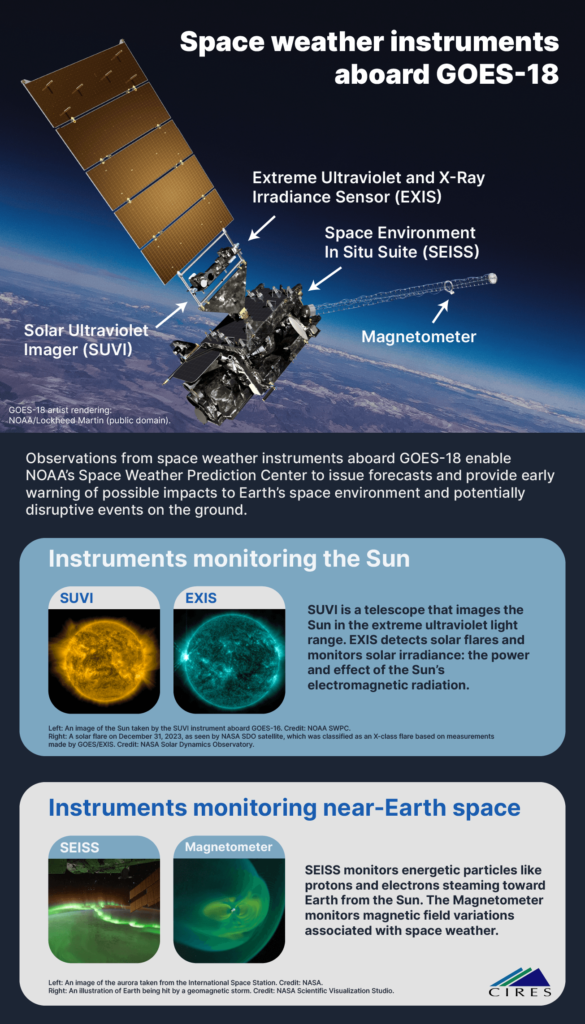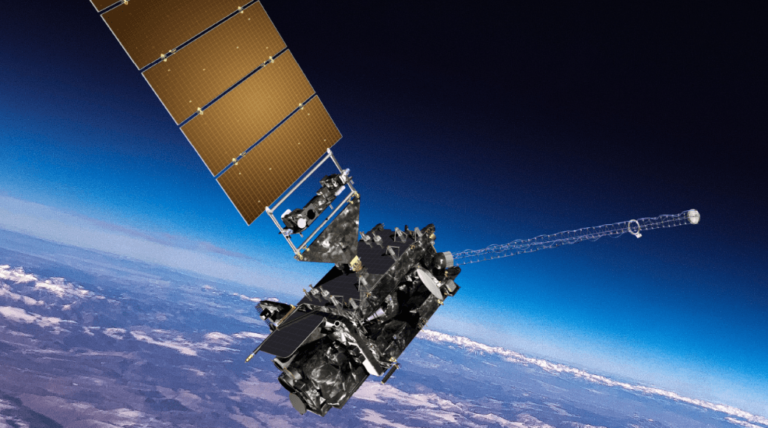CIRES and NOAA researchers have validated the sun and space weather monitoring instruments aboard the GOES-18 satellite in less than two years.
The instruments are now at full operational maturity. Researchers finished final validations for the instruments in December 2023, enabling the instrument data to be considered fully mature just 21 months after launch.
Instruments on board GOES-R satellites monitor terrestrial and space weather, ensuring forecasters can track severe storms, map lightning strikes and monitor potentially harmful particles and radiation heading toward Earth from the sun.
“It was a huge effort for the team,” said Alessandra Abe Pacini, a heliophysics data steward who works in NOAA’s National Centers for Environmental Information (NCEI) with the team that performed the validation of the space weather instrument data. “The team did that in an unprecedented timeline.”
GOES-18 is the third satellite in the GOES-R series, the current generation of NOAA weather satellites. GOES satellites circle Earth in a geosynchronous orbit, meaning they continuously hover above one position on Earth’s surface as they orbit.
According to the team, validation means the instruments and the data have shown they can perform well in a variety of representative conditions. The process of validation involves a period of testing at the end of which instruments are considered operational and their data considered ready to use in forecasting.
The 21 months it took researchers to validate the instruments on board GOES-18 was one-third of the time for the same work on board GOES-16 (59 months) and less than half the time on GOES-17 (46 months).
“They were really fantastic in doing that in such a short time,” Pacini said of the validation team. She explained that CIRES and NOAA researchers in NCEI completed the validation of GOES-18 instruments in record time for several reasons: Because this is the third satellite in the GOES-R series, the researchers were more familiar with the instruments; they were able to apply lessons learned from the first two satellites in the series; and the team was more cohesive.
Forecasters at NOAA’s Space Weather Prediction Center (SWPC) in Boulder, Colorado, use GOES-18 data to monitor solar activity and forecast potentially disruptive geomagnetic storms. GOES-18 has six suites of instruments, four of which monitor space weather and solar activity.
Together, observations from these instruments contribute to space weather forecasts and early warning of disruptions to power utilities and communication and navigation systems as well as radiation damage to orbiting satellites.
“If we have a big solar flare, we’re going to see that in the GOES x-ray data, and that is kind of a tipoff point for forecasters to start looking at the other things like particles,” said Kim Moreland, a CIRES researcher in SWPC who uses GOES data to improve space weather forecast models. “That’s something they use every day.”
In the GOES-R series, GOES-18 serves as GOES-West and orbits over the western contiguous United States, Alaska, Hawaii, Mexico, Central America and the Pacific Ocean, monitoring weather systems and hazards that most affect this region of the western hemisphere. GOES-18 works in tandem with GOES-16, which serves as GOES-East, to cover more than half the globe, from the west coast of Africa to New Zealand. GOES-17 is in orbit as a backup satellite.
Together, GOES-East and GOES-West enable forecasters to provide warnings of space weather hazards responsible for communications and navigation disruptions and power blackouts. They also monitor energetic particles from the sun that can cause radiation hazards to satellites and astronauts aboard the International Space Station.
The NCEI space weather team is now getting ready for the next satellite in the series, GOES-U, which is scheduled for launch at the end of April 2024. GOES-U will have a coronagraph added to its suite of space weather instruments, giving researchers and space weather operators a new view of the sun’s corona.

Read more of the latest solar updates from the meteorological technology industry here, and click here for more on space weather



